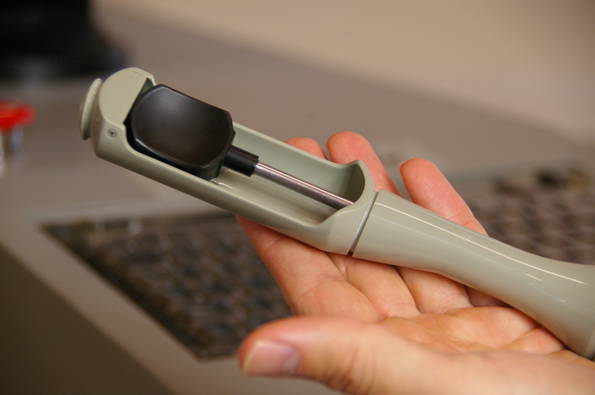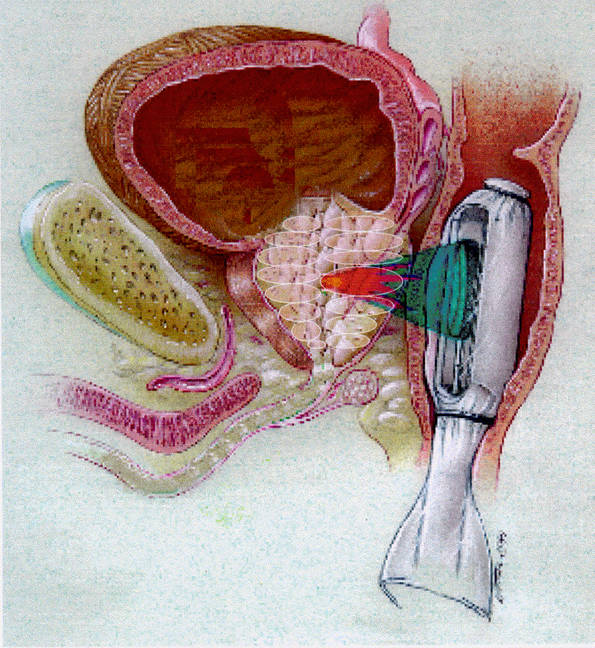HIFU therapy for prostate cancer (PCa)
There are numerous treatment options available for the potentially curable stages of prostate cancer. A radical prostatectomy (complete surgical removal of the prostate) is the most common form of treatment recommended in Germany. However, it is now known that only very few men benefit from having had this type of surgical procedure. Patients aged 65 years and above, which is the age group most frequently diagnosed with prostatic carcinoma, rarely benefit from a radical prostatectomy.
Also, in the case of those patients where a low risk prostatic carcinoma has been determined, there are hardly any benefits to be gained from a radical removal of the prostate.
The HIFU principle using the Sonablate 500
The Clinic for Prostate Therapy has therefore specialised in a new, minimally invasive treatment concept for prostate cancer: HIFU therapy based on the Sonablate 500 principle. HIFU stands for High Intensity Focussed Ultrasound. The procedure uses energy-rich bundled ultrasound. This is different from the ultrasound used for ultrasound imaging, as it is able to produce heated areas with pinpoint accuracy in a predetermined tissue area. The corresponding tissue area can be heated up to between 90°-100°C over a maximum period of 3 seconds and this destroys the tumour cells.


Treatment
The ultrasonic probe is placed directly in front of the prostate via the rectum, so that the energy can be applied directly onto the target organ. A special cooling system prevents the surrounding structures (above all, the wall of the rectum) from over heating. In this way, the entire prostate can be treated so that all tumour cells are destroyed. Surgery is not required here. In this procedure, the sphincter muscle is identified and is not treated, so that incontinence is unlikely. Depending on the location of the prostate tumour, it is possible to protect the potency nerves so that impotence can be avoided. In the case of small tumours which can be precisely located using high-resolution MRI, focal therapy is also considered where applicable. This means that only the area of the prostate where prostatic carcinoma has been detected will be treated. Here, in some cases, the function of the prostate can be fully maintained (including ejaculation). Following treatment, a catheter is inserted via the urethra, as temporary swelling of the prostate occurs. This catheter can then be removed after one or two weeks. However, patients can leave the clinic the day after HIFU therapy.
After treatment
After treatment, the patient will stay in the recovery room. A short follow-up examination is conducted the day after treatment before the patient is released. One can assume a shorter inpatient stay of a total of one to two days due to the minimal stress.
Since the prostate gland has swelled considerably due to the effects of the heat, the patient must wear a catheter for about ten days to avoid urine stasis. The advantages
- Most patients retain their sexual potency after HIFU treatment.
- According to current knowledge, it is expected that HIFU treatment will not cause permanent incontinence, as very often occurs as a result of complete removal of the prostate with the cancer (radical prostatectomy).
- Instead of long stays in the hospital, the patient can usually leave the clinic the day after treatment.
- The minimally invasive treatment is easy on the entire body. It is not just heart patients who profit from this.
- In contrast to other ultrasound methods, the Sonablate 500 procedure also continues to provide ultrasound pictures of the tissue irradiated with ultrasound during the treatment (visually directed HIFU®). This continuous control practically ensures that injuries to the surrounding tissue do not occur.
- The transducer head, which can be toggled, makes it possible to achieve extremely different treatment depths of between 2.5 and 5 centimeters.
HIFU therapy is suitable for whom?
If the tumor has not yet reached its final stage (physicians speak of four disease stages here) then the outlook is particularly good for the first two stages, and in some cases is also good for the third stage.
However, the prostate should not be larger than 40 milliliters. If it is, it would first have to be decreased through hormone treatment. If the prostate is too large, photoselective vaporization treatment (PVP) or ablation (TUR) can be carried out before HIFU treatment.
In addition, the degree of calcification plays a large role: Larger calcifications can hinder the ultrasound waves.
The costs
Overall, in terms of economy, the HIFU procedure is far more cost-effective than conventional or surgical methods. There is no need for expensive hospital stays, rehabilitation and possibly psychotherapy. In Germany, most private health insurance carriers will pay for HIFU treatment. We would gladly prepare a cost estimate or, if applicable, a medical expense plan.
